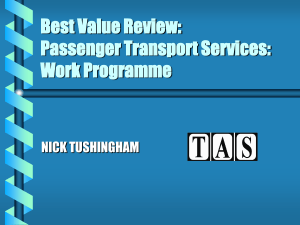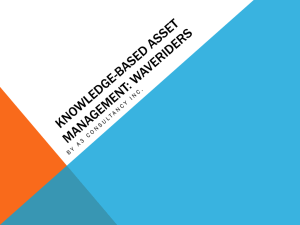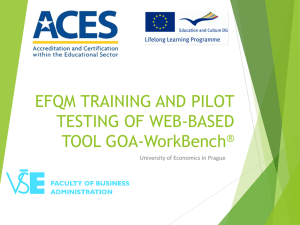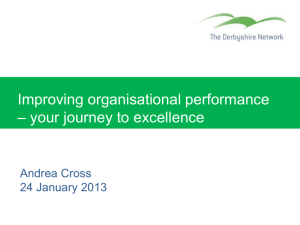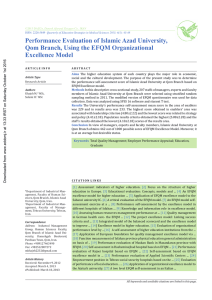Why EFQM?
advertisement
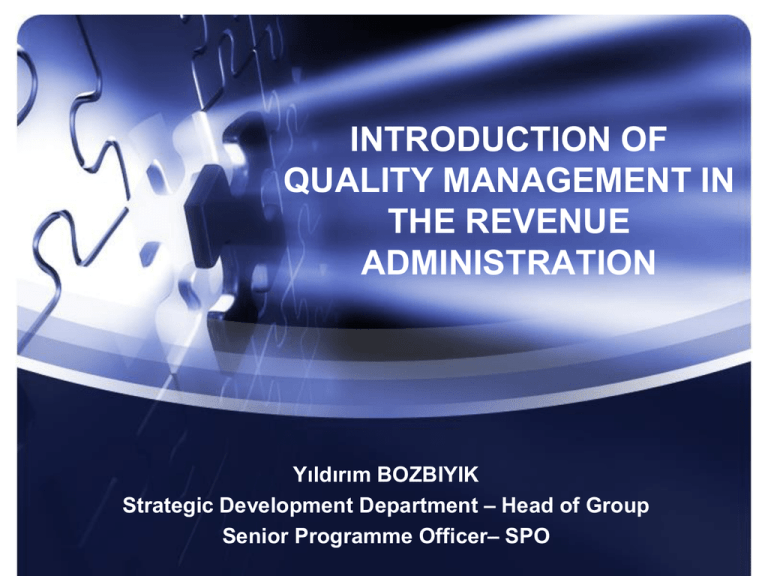
INTRODUCTION OF QUALITY MANAGEMENT IN THE REVENUE ADMINISTRATION Yıldırım BOZBIYIK Strategic Development Department – Head of Group Senior Programme Officer– SPO CONTENT • • • • • TQM Model That Would Be Used Why EFQM? Purposes Project Budget Project Activities – Trainings – Self- assessment – Benchmarking – Process-Based Management System, – Suggestion Improvement System, – Feed-Back System for Employee and Tax Payers, – Employee and Taxpayer Satisfaction Polls • What Do We Succeed TQM MODEL THAT WOULD BE USED EFQM European Foundation of Quality Management Why EFQM? To follow the increasing trend in Total Quality Management over public institutions EFQM is an effective system to achieve: Efficiency, affectivity, accountability, transparency Performance management, Strategic management Participatory Management And also Sustainable success through innovation Purposes • To improve the administrative capacity and efficiency of the tax administration • To train the human resources of TRA with reference to implementation of EFQM excellence model, • To establish the infrastructure for the implementation of EFQM model, • To improve the quality of tax payer services, • To achieve an increase in voluntary compliance with the tax system and increase the tax revenues PROJECT BUDGET Toplam 1.184.300 € Project Activities • Trainings • Establishment of infrastructure for the implementation of EFQM model (Self- assessment- Benchmarking), • Setting of Process-Based Management System, • Creation of Suggestion Improvement System, • Creation of Feed-Back System, • Application of Polls for Employee and Taxpayer Satisfaction TRAININGS Training Target Groups: – TRA headquarter staff (1.550 person), – Staff of Ankara Tax Office Directorate and 6 pilot Tax Offices (480 person) – Trainees that would train the staff of local offices of TRA (500 person) – Staff that would be trained by the trainees ( 35.787 person) – Process management teams(300+ 120) – Self-assessment and benchmarking teams (60+40) Training Programmes: Effective Communication, Process Management, Strategic Management, Process from Strategy, Introduction to EFQM Excellence Model and TQM, Techniques of Problem Solving and Teamwork, Leadership, Benchmarking and Selfassessment Goal: Providing awareness of the new management model and practice of the new management tools. SELF-ASSESSMENT • Is a tool used for diagnosing the strengths and the improvable areas of the organization. • There would be done three self-assessment within the project. Goal: To do self-assessment every year with the staff that would gain competency during the project and to produce projects on y-the improvable areas. BENCHMARKING • Provides defining the improvable areas by comparing the organization with good practice examples. • Organizations, could define their position among the EFQM user organizations, they could also follow their progress Goal: To do benchmarking every year with the staff that would gain competency during the project and to produce projects on the improvable areas. PROCESS BASED MANAGEMENT SYSTEM Activities Within Project: • Analysis of the processes, • Determination of improvable processes • Enabling process standardization, • Linking processes with the strategic planning and developing performance measurement criteria. Goal: Establishing a process based management system and increasing the efficiency of the processes SUGGESTION IMPROVEMENT SYSTEM Goals: • To establish a tool that would enhance the creativity and talent of the staff and also encourage their voluntary participation to the management. • To realize the suggested projects of the staff after a systematic evaluation process. FEED- BACK SYSTEM FOR THE EMPLOYEE AND TAX PAYERS Goals: • To establish a tool for diagnosing the expectations and needs of the staff and the tax payers, • Evaluating the feed-backs and solving the problems they face, • Through the feed-backs, increasing the efficiency and the quality of the services. EMPLOYEE AND TAX PAYER SATISFACTION POLLS Goals: • Taking feed-backs from our inner and outer partners in order to determine our strengths and improvable areas within the framework of EFQM Model. • Through the feed-backs, increasing the efficiency and the quality of the services. WHAT DO WE SUCCEED? • Awareness and competency of all employees about EFQM and it’s tools. • Increase in efficiency and satisfaction of the employees through a just, progressive and participatory management. • Increase in tax payer satisfaction. • Establishment of process based management system which would enable practicing the strategies more effectively and would increase the efficiency of processes. • Increasing the voluntary compliance as a result of the increase in both employee and tax payer satisfaction and also the increase in efficiency of the processes. THANK YOU Excellent Management of Revenue
